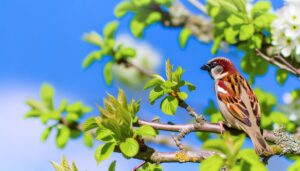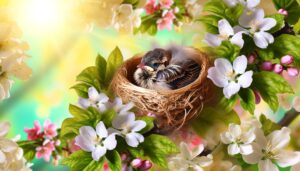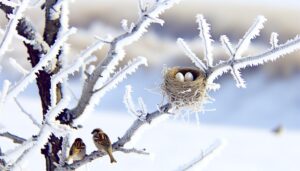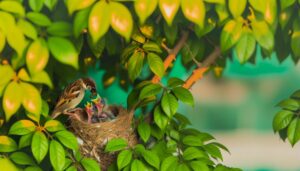5 Steps to Safely Bathe a Baby Sparrow
To bathe a baby sparrow, start by gathering a shallow dish, lukewarm water (100-105°F), a soft cloth, and bird-safe soap. Prepare the bath area with supplies nearby and maintain a calm environment.
Fill the dish with lukewarm water, checking the temperature with a digital thermometer. Dribble water over the sparrow from head to tail, avoiding the eyes and face.
Apply a gentle, unscented soap with your fingers, massaging lightly. Rinse thoroughly with lukewarm water and make sure no soap residue remains.
Dry the sparrow gently with a soft towel and keep it warm. For a more detailed approach, there's more to take into account.
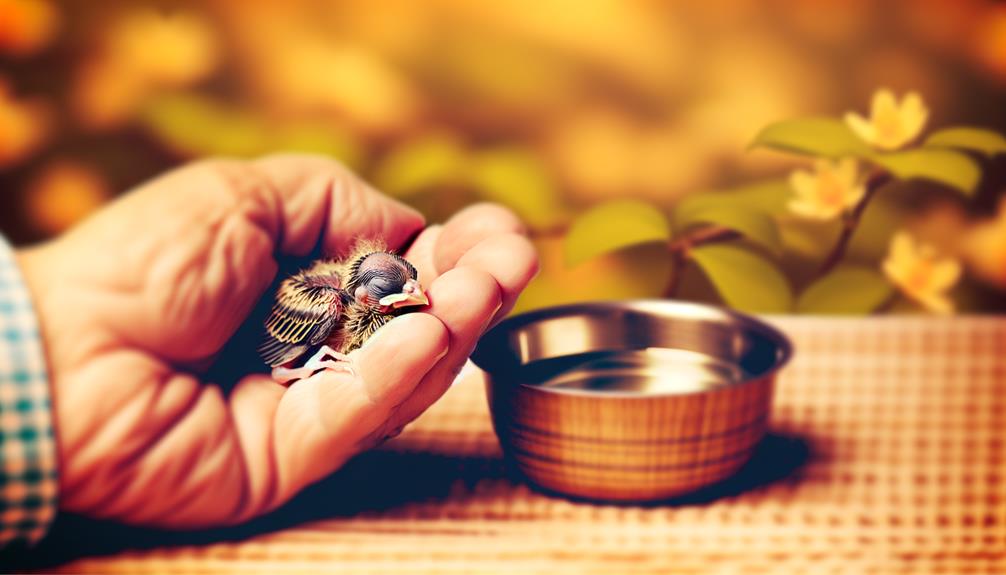
Key Takeaways
- Use lukewarm water (100-105°F) in a shallow dish to prevent submersion.
- Gently dribble water over the sparrow, avoiding the face and eyes.
- Apply bird-safe, unscented soap with a soft cloth or fingertips.
- Thoroughly rinse with lukewarm water to remove all soap.
- Pat dry with a soft towel and keep the sparrow in a warm environment.
Gather Necessary Supplies
To successfully bathe a baby sparrow, you'll need to gather a shallow dish, lukewarm water, a soft cloth, and a gentle bird-safe soap.
Choose a shallow dish to guarantee the sparrow isn't submerged. Lukewarm water mimics the bird's natural environment, reducing stress. A soft cloth will be gentle on the sparrow's delicate feathers and skin. Use a gentle, bird-safe soap to avoid harmful chemicals and maintain the bird's natural oils.
These supplies are essential to guarantee the sparrow's safety and comfort. By carefully selecting and preparing these items, you're setting the foundation for a successful and stress-free bathing experience.
Prepare the Bath Area
First, place all gathered supplies within easy reach to maintain a smooth workflow.
Next, fill a shallow container with lukewarm water, ensuring it's neither too hot nor too cold.
Gather Necessary Supplies
Make sure you have a shallow dish, lukewarm water, and a soft cloth ready before starting the bathing process.
Begin by selecting a shallow dish, about one inch deep, to guarantee the baby sparrow won't submerge and risk drowning. Fill it with lukewarm water, around body temperature, to provide a comfortable bathing experience. Place the dish on a stable, flat surface to prevent spills.
Have a soft, absorbent cloth on hand to gently dry the sparrow after the bath. Make certain the cloth is clean and free from any detergents or chemicals that could harm the bird.
Choose Proper Temperature
Guaranteeing the water temperature is just right is essential for the baby sparrow's comfort and safety.
Begin by filling a shallow dish with lukewarm water, ideally between 100°F and 105°F (37.7°C to 40.5°C). Use a digital thermometer to measure the water temperature accurately. Too hot or too cold, and you risk distressing or harming the bird. Adjust the faucet as needed until you achieve the desired temperature.
Once the water is ready, place the dish on a stable surface in a quiet area. Double-check the temperature before introducing the baby sparrow to the bath, as it can fluctuate.
Taking these steps guarantees a comfortable and safe bathing experience for the delicate creature in your care.
Ensure Safe Environment
Once you've set the proper water temperature, it is crucial to prepare a safe and controlled environment for the baby sparrow's bath. Clear the area of any potential hazards. Make sure that all materials are within reach to avoid leaving the bird unattended. Use a shallow dish with a non-slip surface to prevent slipping.
Prepare the following materials:
| Material | Purpose |
|---|---|
| Shallow dish | Safe bathing container |
| Towel | Drying and warming the sparrow |
| Cotton swabs | Gently cleaning delicate areas |
| Thermometer | Monitoring water temperature |
| Small cup | Pouring water gently over the sparrow |
Place the dish on a stable surface. Finally, maintain a calm atmosphere to prevent stressing the sparrow. Your systematic preparation ensures the sparrow's safety and comfort.
Use Lukewarm Water

Using lukewarm water, rather than hot or cold, is crucial to maintain the baby sparrow's delicate body temperature during the bath. Here's how you can confirm the water is just right:
- Measure the Temperature: Use a thermometer to check that the water is between 100-105°F (37-40°C).
- Prepare a Shallow Dish: Fill a shallow dish with the lukewarm water, making sure it's no deeper than 1 inch to prevent drowning.
- Stir the Water: Stir the water gently to equalize the temperature throughout the dish.
- Test with Your Wrist: Dip your wrist into the water to verify it feels comfortably warm, not hot or cold.
Gently Wet the Sparrow
Carefully scoop a small amount of the lukewarm water with your hand or a soft cloth, and gently dribble it over the baby sparrow's feathers to avoid startling it. Guarantee the water flows evenly, mimicking a light rain.
Start from the head and work towards the tail, maintaining a calm demeanor to keep the bird relaxed. Observe the sparrow closely for any signs of distress, and adjust your technique if necessary.
Avoid wetting the bird's face and eyes. Instead, focus on the body, wings, and tail feathers. Remember, the goal is to dampen the feathers without soaking them completely.
This methodical approach assures the sparrow stays comfortable and safe throughout the process.
Apply Mild Soap
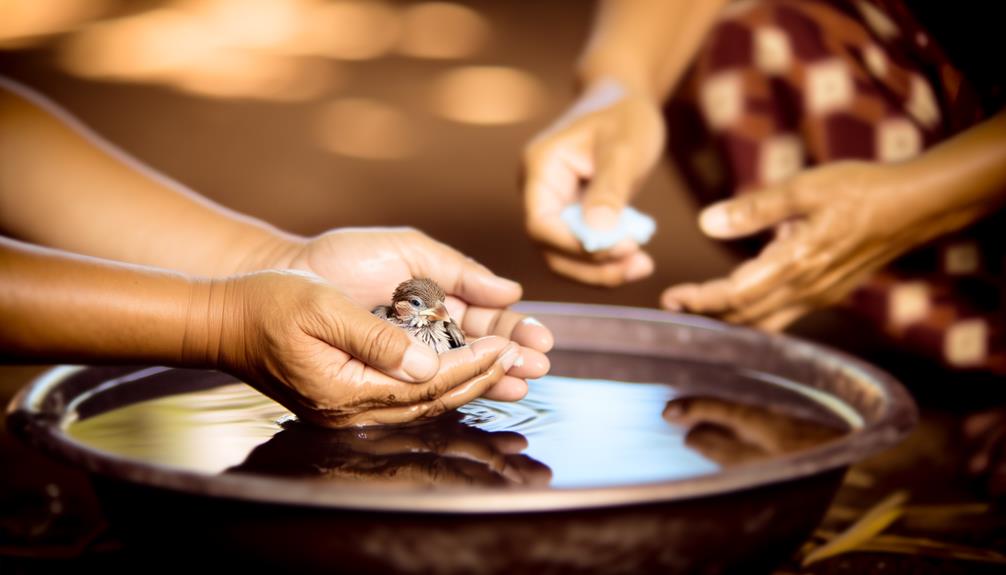
After dampening the sparrow's feathers, apply a small amount of gentle, unscented soap to a soft cloth or your fingertips to start the cleaning process. Gently work the soap into the feathers, focusing on areas that appear dirty or greasy. Be systematic and tender to avoid causing stress or harm to the fragile bird.
Steps to apply soap:
- Use gentle, unscented soap: Choose a soap devoid of scents and harsh chemicals.
- Apply conservatively: A small amount is adequate; excessive use can harm the sparrow's skin.
- Soft cloth or fingertips: Both are effective for delicate application.
- Tender strokes: Lightly massage the soap into the feathers without undue pressure.
This guarantees the sparrow remains calm and clean.
Rinse Thoroughly
Once you've thoroughly lathered the sparrow with soap, rinse the bird meticulously with lukewarm water to verify all soap residue is removed. Use a gentle stream to avoid overwhelming the bird. Hold the sparrow securely but gently, making sure water flows from head to tail to prevent soap from entering its eyes or mouth. Keep the water temperature consistent to avoid shocking the bird.
Check the feathers for any leftover soap, as residue can cause skin irritation and affect the bird's ability to regulate its temperature. If necessary, repeat the rinsing process until the water runs clear. Patience is key; thorough rinsing secures the sparrow's comfort and health.
Your careful attention makes a significant difference in the bird's well-being.
Dry and Warm the Sparrow
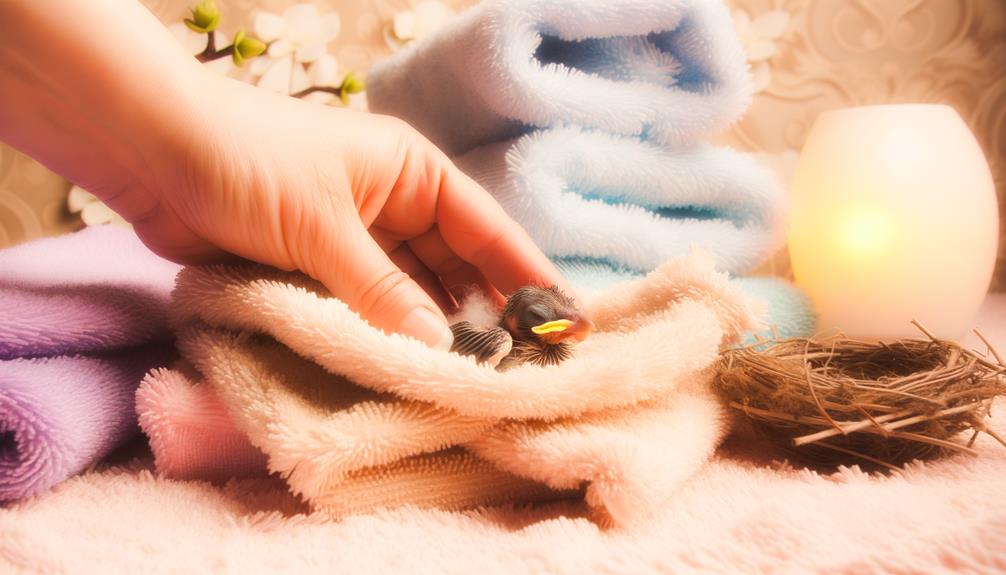
Drying the sparrow promptly is crucial to prevent hypothermia and secure the bird's feathers regain their insulating properties. Follow these steps to confirm the sparrow is dry and warm:
- Gently Pat Dry: Use a soft, absorbent towel to carefully pat the sparrow's feathers. Avoid rubbing, as this can damage delicate plumage.
- Low-Heat Hair Dryer: Set a hair dryer on the lowest heat setting and keep it at least 12 inches away. Move it continuously to avoid overheating any one spot.
- Warm Environment: Place the sparrow in a warm, draft-free area. An incubator set to 85-90°F is ideal.
- Monitor Closely: Watch the sparrow for signs of stress or chills. Adjust the warmth as necessary to maintain comfort.
Following these steps helps secure the sparrow's well-being.
Conclusion
Coincidentally, as you meticulously bathe the baby sparrow, you're doing more than just cleaning its feathers. You're fostering a bond, nurturing trust, and ensuring its survival.
Remember, use lukewarm water, mild soap, and dry the sparrow thoroughly to keep it warm. This methodical care isn't just about hygiene; it's about giving this tiny creature a chance to thrive.
Your careful attention to detail speaks volumes about the tenderness and responsibility we owe to all living beings.


